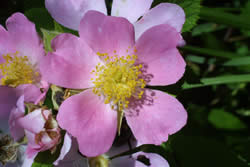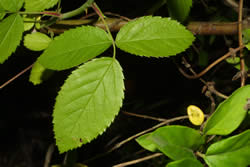Plant of the Week
 Range map of prairie rose. States are colored green where the species may be found.
Range map of prairie rose. States are colored green where the species may be found.
 Close up of prairie rose flower. Photo by Steven J. Baskauf.
Close up of prairie rose flower. Photo by Steven J. Baskauf.
 Close up of prairie rose leaves and stems. Photo by Steven J. Baskauf.
Close up of prairie rose leaves and stems. Photo by Steven J. Baskauf.
Prairie Rose (Rosa setigera Michx.)
Prairie rose, also called "climbing rose," is a member of the Rosaceae (Rose) family. The rose family includes well-known species as diverse as garden roses, strawberries, apples, peaches, and blackberries. Roses typically have leaves with 3 to 9 leaflets, stems with hooked prickles (“thorns”) or bristles, and upright or arching stems (canes). Flowers have a base petal number of five, with many cultivated roses showing a hundred or more petals.
Prairie rose usually has three leaflets, but may have five. The stems are bright green to reddish green and clambering. They use adjacent vegetation and fences for support. They can reach more than 4 meters (approximately 13 feet) long. Flowers on prairie rose are about 6 to 8 centimeters (2.5 to 3 inches) across, with five light pink petals and a yellow center. Prickles are few and far apart on the stem.
As the name suggests, prairie rose is a species of open lands occurring in and at the edge of prairies, woodlands and savannas, and in fencerows and thickets. It is sometimes found at the edge of forests. It is found from New York and New Hampshire south to Florida, west to Texas, north to Nebraska, Iowa, Wisconsin, and Ontario. Other native roses generally have 5 or 7 leaflets, are more heavily armed, have smaller flowers, and/or are more compact branching shrubs.
The species can be cultivated and is frequently sold by nurseries. It needs climbing support and ample sunlight. It is drought tolerant, but does best with regular watering in well-drained soils. The fruit or hip is edible, but is full of irritating hairs so should be carefully cleaned before consumption.

